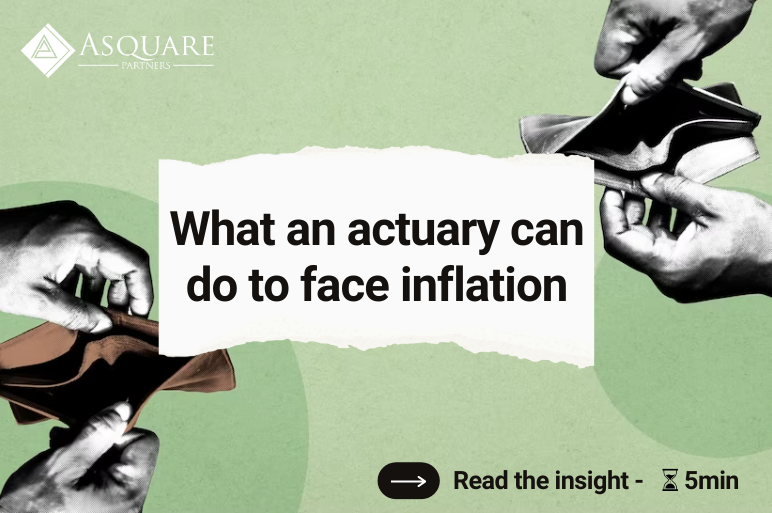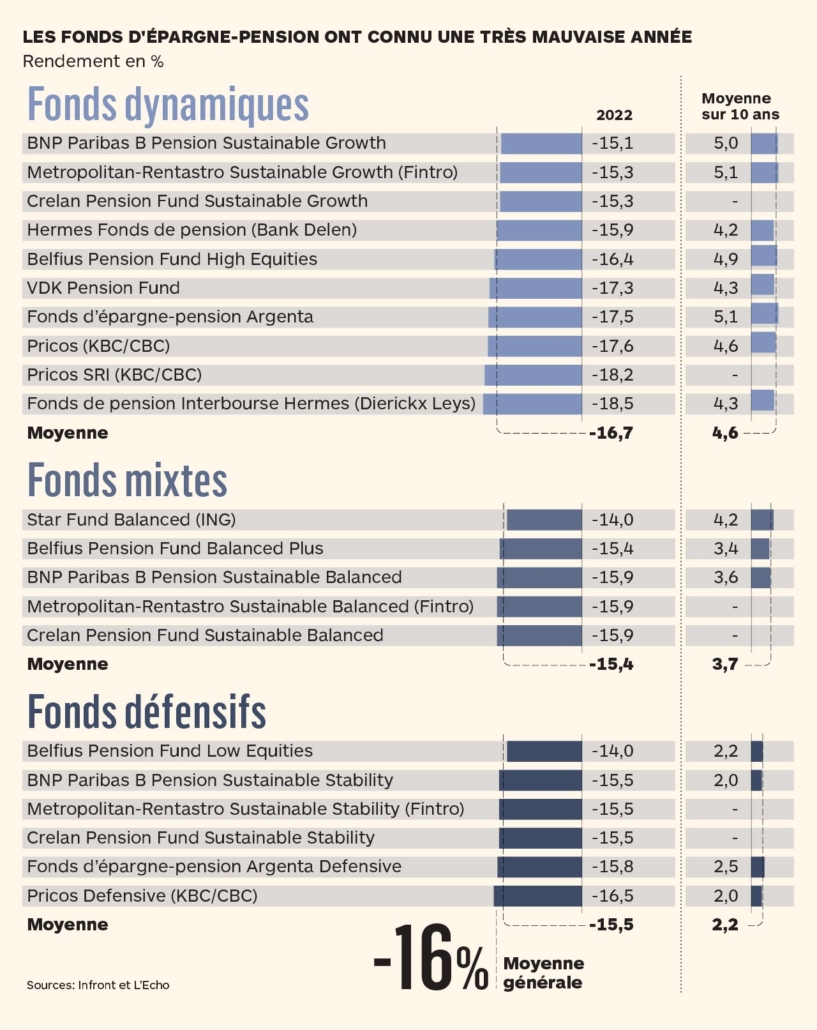What an actuary can do to face inflation
Estimated at 10,7% in 2022 in the Eurozone, the inflation unsurprisingly hits the European insurance market for several months. The role of actuaries at different levels, such as costs, product development, covers, evaluation of the balance sheet and measurement of capital requirements, is a key element that insurance companies need to consider to remain competitive.
Impacts of inflation on the insurance market
As many other actors, insurers do need to deal with inflation and its consequences. The decrease in purchasing power, the increase in claim costs in P&C insurance and in medical covers, and the loss of market assets are all examples of negative short-term consequences that need to be controlled. On the contrary, the rise in interest rates, for instance, provides an active return in the long term: indeed, this effect allows bonds to be redeemed at higher rates. Regarding savings products with a secured interest rate, they are advantageous for both the investor and the insurer, who can obtain a higher bond yield.
Moreover, on the mid-term, inflation increases risk awareness, influencing customers in taking out more advantageous life insurance products, such as units of account. When taking out these products, money is invested in different types of assets that will adjust to inflation, such as real estate. The insurers’ life insurance taxation framework will therefore generate increasing cash flows.
Lastly, the impacts of a changing monetary policy will have consequences on technical provisions, capital requirements and related monitoring tools. Indeed, current methods used do not estimate realistic technical provisions because they do not adapt to inflation, as these methods have not been adjusted for more than twenty years. In addition, buying life insurance policies, immediate consequence of the decrease in purchasing power and the increase in interest rates, influences these estimates.
Regarding capital requirements, it is recommended to review inflation-related parameters of internal model to meet the SCR. It should be noted that inflation also affects risk management policies and models.
Globally, we can notice that inflation influences positively and negatively the insurance market.
Undertaking actions at different levels
In addition to the above-mentioned consequences, the inflationary pressure urges insurers to look at their product and reserving strategies.
A concrete example concerns the competitiveness of insurance companies in relation to offered guarantees. Understanding how these guarantees are calculated and determining their level in new products will therefore be of primary importance. A solution to determine their level is to reduce underwriting risk by considering even more the policyholder’s experience, or by asking policyholders if their needs have changed and if some insurance policies can be brought together. Another solution may lie with the policyholder if he·she is willing to change insurance policies regularly.
As a result, understanding and monitoring the market as it changes is a required behavior in a future and uncertain socioeconomic context.
As far as pricing is concerned, inflation also affects projections of future premiums. The increase of claims costs and other risks (i.e. climate-related) are factors to consider. However, inflation does not influence life and non-life insurance similarly. On the non-life hand, the IABE has already noticed that some non-life insurance premiums are undervalued of 8%. Nevertheless, short-term contracts allow to adapt more easily to the influence of inflation. In this respect, inflation has a forward-looking effect. The situation is different for longer-term life insurance contracts. A new challenge is to adequately price savings products with a guaranteed interest rate to yield a return on invested premiums. Inflation has therefore a retrospective effect on the life hand.
Moreover, the impact of political decisions when pricing productsshould be considered. Bruno Lemaire, French Minister of Economy, for instance, decided to limit the insurance index so that it does not increase compared to the consumer price index. However, it is necessary to be extremely careful when adapting premiums, as regulatory instances require a substantiated justification.
If we look at the solvency of insurance companies, evidence shows that inflation affects both life and non-life business. In such an inflationary context, reinsurance may be of useful help for insurers, more specifically by discussing with experts how to set up adequate reserves. Moreover, the APREF thinks that the current economic situation, and the possible stagflation, could influence prices and the scope of reinsurance cover. Therefore, there is a need for insurers to engage and interact more with reinsurers.
“Understanding and monitoring the market as it changes is a required behavior in a future and uncertain socioeconomic context.”
Opportunities available to actuaries
Although we have discussed the impacts of inflation on the industry and the associated changes to be adopted, it is needless to say that the core business of actuaries will also be subject to adaptations, regardless of the degree of implication in the value chain.
With the increase in costs of claims coming from the rise in raw materials and automobile parts, it matters to reconsider how insurers deal with claims. Actuaries working in this area may tap into other budgets and choose a new method to reprice products after inflation. The insurance company may also change its pricing policy by adopting a competitive strategy regarding what is being done in the market or simply by deciding how many product lines to increase to maintain a certain number of policyholders.
Regarding non-life pricing, it is recommended to use extrapolation techniques which already take inflation into account. Adapting previous cash flows to current inflation in models is another method that can be used. On the whole, considering past figures as good indicators of future behaviors is also interesting. Another approach consists in using the pricing of inflation swaps and index-linked bonds to better evaluate future inflation.
If we tackle the ALM strategy, another necessary step is to model inflation. Specific models can link inflation by rates. Indeed, using LMM or Vasicek models allows to model real and nominal rates in order to determine inflation. Besides, simultaneously determining real and nominal rates and inflation is also possible via autoregressive models such as Jarrow-Yildirim model. Lastly, using inflation swaps that swap fluctuating inflation for fixed inflation allows for more accurate predictions as it reduces future volatility.
Additionally, although there is an influence of inflation on liabilities, especially on products, asset coverage is still too poor. Some elements could be used as natural coverage. For instance, inflation-linked products, interest-rate products and equities with a strong pricing power could be the solution, even if these are scarce products. Concerning equities, further reflection is required as the classification of risks is not as clear as for credit risk and its financial ratings. It is therefore necessary to catch risk factors that identify equities more prone to inflation. However, paying attention to these factors can allow for a considerable evolution and better visibility on the market in such a situation.
Lastly, a global reflection on how reserves can be increased and how this increase can be established should be encouraged. Similarly to the adaptation of insurance products premiums, reserving is a key matter to face inflation, even if inflation were to weaken.
“It seems natural to consider that the market will still be confronted with these conditions in the future, especially with the already evident consequences of global warming.”
Final words
Inflation and the economic and social chaos caused are not likely to leave us any time soon. Each actor in the financial sector must take it into account to improve the comfort of living of citizens and the perennity of companies. As an actuary, adapting his/her strategic vision and implementing changes in traditional methods used in daily work are actions that must be taken to meet these objectives.
Concretely, it seems natural to consider that the market will still be confronted with these conditions in the future, especially with the already evident consequences of global warming. Actuaries will need to deal more and more with these situations which cause rates volatility and instability on assets. This is what the European Actuarial Association remind us: “As actuaries, we have taken too much time thinking that inflation belonged to the past. After all, the history taught us that …”
Sources
- Institut des actuaires, Le retour de l’inflation, un défi pour les actuaires.
- L’Echo, Les primes d’assurance sont sous-estimées de 8%
- Corum, Le retour de l’inflation, quel impact sur le marché de l’assurance vie ?
- Le Figaro, L’inflation va peser sur le marché de l’assurance, selon une étude de Swiss Re
- L’APREF, Note inflation et réassurance Non-Vie
- You talk insurance, What is the impact of high inflation on insurance
- The European Actuary Magazine, Inflation and insurers, p.18
- EIOPA, Trying times and their effect on insurers
- Institut des actuaires, Inflation : Quels risques pour le secteur de l’assurance ? Quelle stratégie ALM ?
- EIOPA, EIOPA publishes supervisory statement on inflation

























